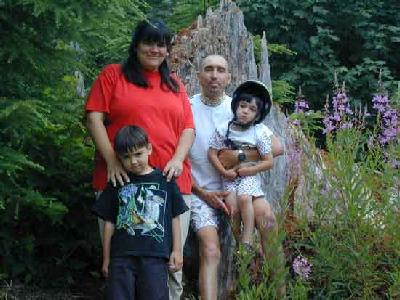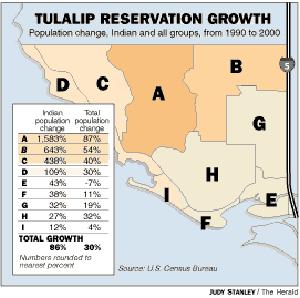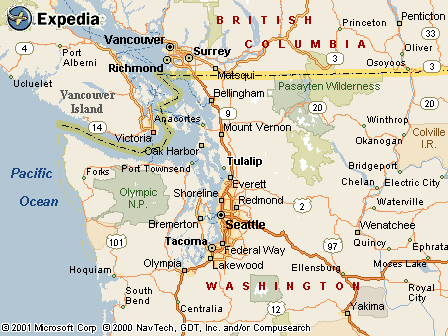|
|
Canku Ota |
|
|
(Many Paths) |
||
|
An Online Newsletter Celebrating Native America |
||
|
July 28, 2001 - Issue 41 |
||
|
|
||
|
Tulalips Home Again |
||
|
by Theresa Goffredo Everett Herald Writer- July 19, 2001 |
||
|
Herald Writer Warren Cornwall did the data analysis for this story |
 TULALIP
-- Growing up in New Mexico, Dana Krsnadas often found herself trying to explain to friends and others about her
Tulalip background. But people didn't really seem to get it. They'd mispronounce Tulalip. And they didn't know
about the traditions, the treaties, the family histories. TULALIP
-- Growing up in New Mexico, Dana Krsnadas often found herself trying to explain to friends and others about her
Tulalip background. But people didn't really seem to get it. They'd mispronounce Tulalip. And they didn't know
about the traditions, the treaties, the family histories. For the most part, neither did she. "I was one of those people without an identity," Krsnadas said. That changed in August, when she and her husband, Dharma, plunked a thoroughly modern modular onto Tulalip reservation land to create a home base from which to steep their children in tribal tradition. Though her dad wasn't Tulalip and though she was raised four states away, Krsnadas always knew she would one day be back. "I have two young children and one on the way, and I want them to understand where their ancestors have come from," Krsnadas said. "I'm 35 now, and I didn't have that when I was growing up, other than the bits and pieces that we were able to hold onto, and I just don't think that's something our children should let go of." Krsnadas and other Tulalips are proving, en masse, that author Thomas Wolfe was wrong: you can go home again. That's what the Tulalips have done during the past 10 years. Since the 1990 census was taken, the American Indian population on the Tulalip Reservation has grown 86 percent. The population growth on the reservation overall has grown 30 percent. This significant return to the reservation marks a historical reversal from when American Indians were forced by economic reasons to leave the reservation to look for work. Now, jobs -- and plenty of them -- can be found on the reservation. "On the Tulalip, it's an economic microcosm. It really is," said Bernie LeClaire, the Puget Sound chapter of the Bureau of Indian Affairs loan officer for economic development. "It's kind of a historical thing that jobs are being created on the reservation for tribes, and it's very diverse jobs, not just a casino job anymore." Employment opportunities include work at the newly created Quil Ceda Village business park, where Wal-Mart and Home Depot are the biggest retail anchors. Krsnadas' aunt, Diane Janes, sees the economic opportunities for tribal members in several facets, such as scholarships and computers tribal leaders might give to qualifying members. "Where there's a job, it's been an economic boom," Janes said. "It can buy houses, it can buy a vacation. It can buy an education. It has sort of (catapulted) us, and we've really grown up very fast, and now we're a major player in the corporate America." But Tulalips returning to the reservation aren't coming back just for a job. Krsnadas and others are examples of people returning home just to be home, to reconnect with their families, their language and culture, said Robert Anderson, director of the Native American Law Center at the University of Washington. "It's very important to be in their aboriginal areas, to continue hunting and fishing activities and participate in other important cultural activities," Anderson said. "And be with those who share those bonds."  Stan Jones Sr., vice chairman of the Tulalip Tribes' board of directors, left the reservation as
a young man for a job in Seattle but returned to be closer to his people. Stan Jones Sr., vice chairman of the Tulalip Tribes' board of directors, left the reservation as
a young man for a job in Seattle but returned to be closer to his people. "I think a lot of people believe that when they move away, that some day they'll be coming back," said Jones, 70. "As a tribal member, you don't forget what draws you back." The increase in numbers on the reservation may be skewed somewhat because of improved efforts to count the nation's American Indians. Nationwide, the undercount of Indians fell from 12 percent in 1990 to 5 percent in 2000, according to the census bureau. "There is a very concerted effort to count Native Americans on reservations," said Judy Joseph, the BIA's acting superintendent for the Puget Sound office. "It's not that they have returned, but a portion of those on the reservation in reality have been there and are now truly being counted." But Joseph knows first-hand that the Tulalip Reservation has grown, saying her husband's uncle recently returned after a 30-year absence. The current challenge to the growth, Joseph said, is housing. Today, the tribes are busy building housing, including a 38-unit subdivision called Maplewood. Qualifying tribal members also can receive financial assistance in finding a home. Zenitha Jimicum, 24, received a $2,000 loan from the Tulalips to help get her and her 14-month-old son, Spencer, into an apartment in Everett. Raised by foster parents in Eastern Washington, Jimicum returned to Tulalip to be closer to her mother and family. Though she works at the casino, Jimicum has a bachelor of arts degree in social work and is looking for a job in her field. Jimicum knew she could get a job easily if she returned to Tulalip, but her motivation to return home wasn't economic. "I feel I'm kind of more connected," Jimicum said. "And another reason is to make sure my son is raised near the tribe and to have that accessible to him as well." Krsnadas knows economics wasn't an issue in her family's decision to live on Tulalip. Krsnadas teaches business and marketing at Marysville-Pilchuck High School, but before she got that job, she applied to 30 other places, had lots of interviews and had planned to stay in Eastern Washington where her husband was looking to get into a nursing program. But her older brothers lived on Tulalip and her mother was moving back. And she had lots of history to catch up on. The draw was too strong. "I want to try and get to know them and try to understand better where I come from," Krsnadas said. "And more importantly, for my children, because that was something I didn't have growing up. And I wouldn't say that I missed out, but it was very important for me that they at least understand it." |
|
|
|
|
||
|
|
||
| Canku Ota is a free Newsletter celebrating Native America, its traditions and accomplishments . We do not provide subscriber or visitor names to anyone. Some articles presented in Canku Ota may contain copyright material. We have received appropriate permissions for republishing any articles. Material appearing here is distributed without profit or monetary gain to those who have expressed an interest. This is in accordance with Title 17 U.S.C. section 107. | ||
|
Canku Ota is a copyright © 2000, 2001 of Vicki Lockard and Paul Barry. |
||
|
|
|
|
|
The "Canku Ota - A Newsletter Celebrating Native America" web site and its design is the |
||
|
Copyright © 1999, 2000, 2001 of Paul C. Barry. |
||
|
All Rights Reserved. |
||

